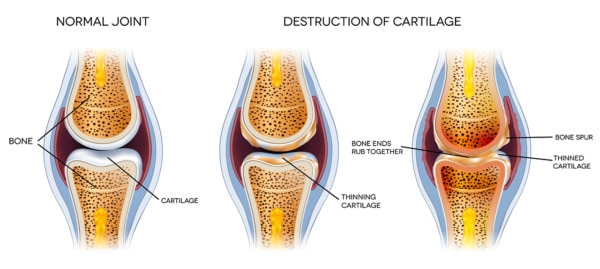NSAIDs vs. Exercise for Knee Arthritis
We are an NSAID society. I can’t tell you how many 35+-year-old patients I have who rely on these anti-inflammatory drugs to function. This is often due to chronic arthritic knee pain. However, new research suggests that these patients may be better off exercising and ditching the Motrin.
A Review of Exercise for Knee Arthritis
The benefit of exercise for knee arthritis isn’t a new topic on this blog. A new diagnosis of knee arthritis shouldn’t be a free pass to get you out of all future activities; it should, instead, be your red-flag warning that it’s time to strengthen your knee before your arthritis gets worse.

The progression of Knee arthritis. Tefi/Shutterstock
Knee arthritis affects both the cartilage and the bone that make up the joint. Cartilage is a cushion between the bones that absorbs shock, and its slick surface allows the bones to glide smoothly with movement. Arthritis occurs when the cartilage wears down—this could be due to normal wear and tear, injury, or even disease. This can create instability and cause bone spurs to form to protect the degenerating joint. Knee arthritis is associated with pain, inflammation, problems with function, and other symptoms. Many other studies have shown the effects of exercise on knee arthritis pain, including a few we’ve covered in the past:
- Exercise can decrease knee arthritis pain by strengthening the muscle.
- Exercise may decrease severe knee arthritis pain by nearly 40%.
- Non-weight-bearing exercises may be the best option for knee arthritis pain relief.
So we have research that shows that exercise can help arthritic knee pain. However, how does exercise compare to doubling up on the Motrin?
The Benefits of Exercise for Knee Arthritis over Drugs
The purpose of the new study on mild to moderate knee arthritis was to determine the long-term effect on patients who participate in exercise versus those who pop NSAID drugs like Motrin, Aleve, Celebrex, etc… Ninety-three subjects with knee arthritis were randomly assigned to either an exercise group or a drug group (acetaminophen and nonsteroidal anti-inflammatory drug [NSAIDs]) and given instructions for eight weeks. Twelve months later, patients completed comprehensive questionnaires, providing feedback on pain and other symptoms, functionality (e.g., mobility, such as walking up or down stairs; self-care, such as getting dressed; etc.), sports and recreational activities, and quality of life.
The result? While there was no significant difference in sport-related activities (e.g., the ability to run, jump, squat, etc.) within either group, pain, symptoms, function, etc. showed more improvements in the exercise group.
Popping an NSAID Might Be Easy, but It’s Also Dangerous
Popping an NSAID might be easy, but this new study suggests that exercise is a more effective treatment for the symptoms of knee arthritis. In addition, many studies have shown that NSAIDs put us at risk for dangerous side effects, and the list of reasons why not to take NSAIDs never seems to stop growing:
- NSAIDs could possibly make arthritis worse.
- NSAIDs don’t actually relieve pain in everyone.
- NSAIDs carry an increased for sudden-death strokes and heart attacks.
- NSAIDs taken for only a week increase heart attack chances by 50%.
- NSAIDs are associated with gastrointestinal (GI) bleeding and other GI issues, kidney dysfunctions, and heart disease.
- NSAIDs may disrupt the formation of new bones, the function of stem cells, and the ability to heal.
- NSAIDs have been linked to Alzheimer’s disease.
- NSAIDs more than double the risk of miscarriage when taken in early pregnancy.
There are things you can do to end your reliance on NSAIDs for pain. Obviously, start an exercise program focused on knee strengthening. In the meantime, if pain relief is necessary, there are high-quality supplements that can help, such as glucosamine and curcumin that can reduce inflammation, address arthritis pain, and even protect cartilage.
The upshot? Ditch the Motrin and start a knee-strengthening and exercise program to help knee arthritis pain. While it seems like it’s easy enough to buy an NSAID drug at the local supermarket, this is one of the most dangerous drugs on the pain-relieving aisle!

NOTE: This blog post provides general information to help the reader better understand regenerative medicine, musculoskeletal health, and related subjects. All content provided in this blog, website, or any linked materials, including text, graphics, images, patient profiles, outcomes, and information, are not intended and should not be considered or used as a substitute for medical advice, diagnosis, or treatment. Please always consult with a professional and certified healthcare provider to discuss if a treatment is right for you.
